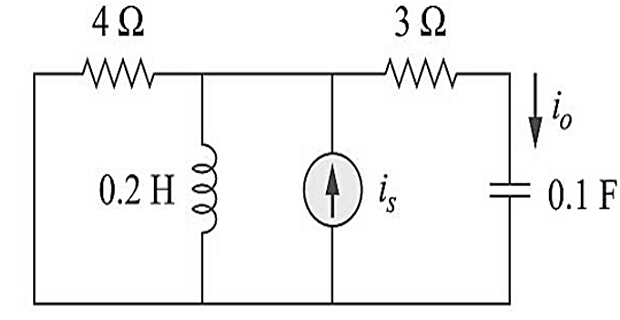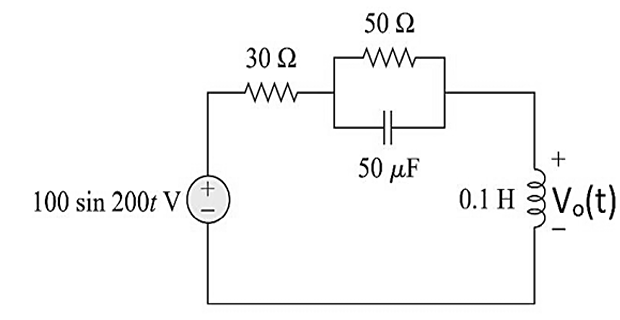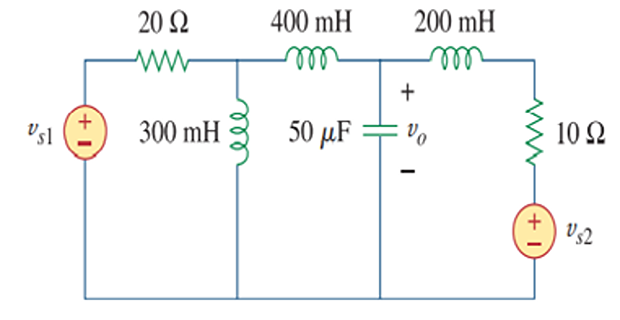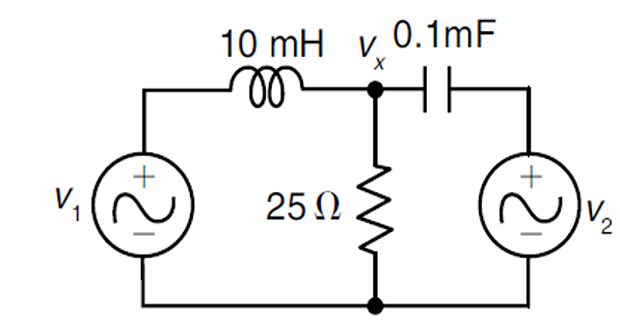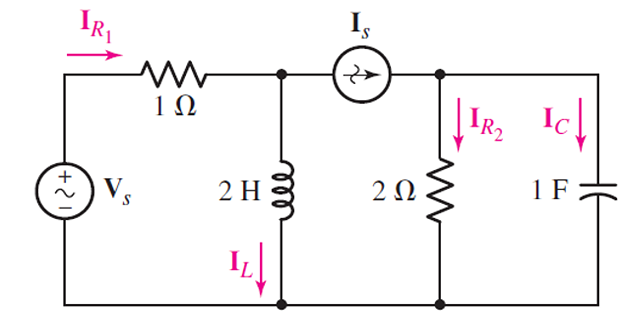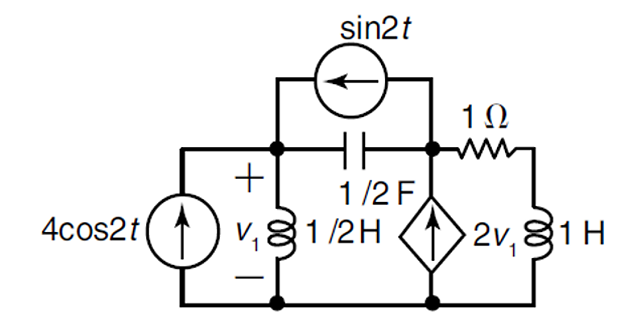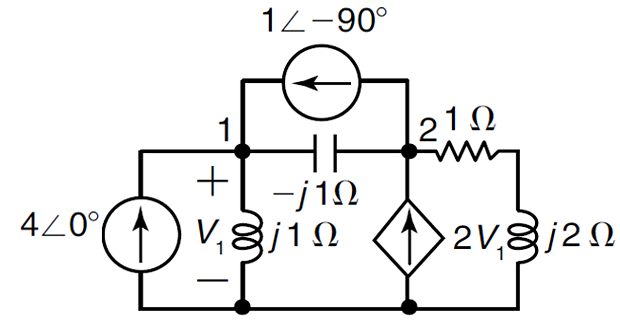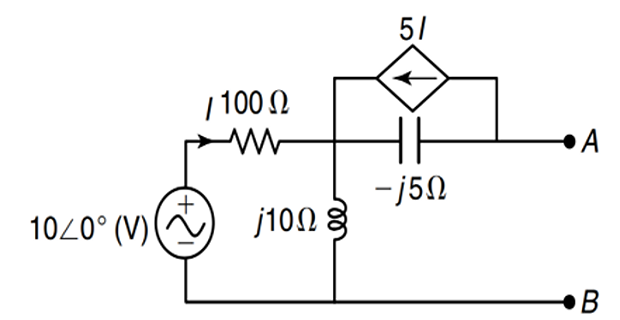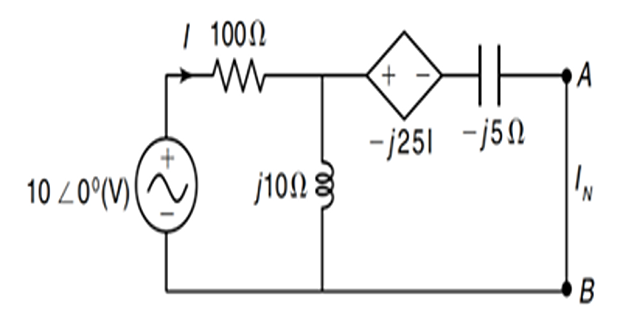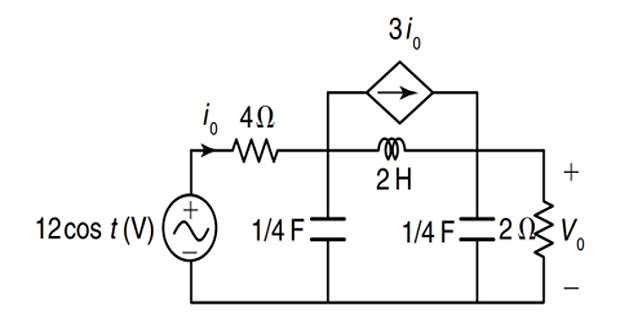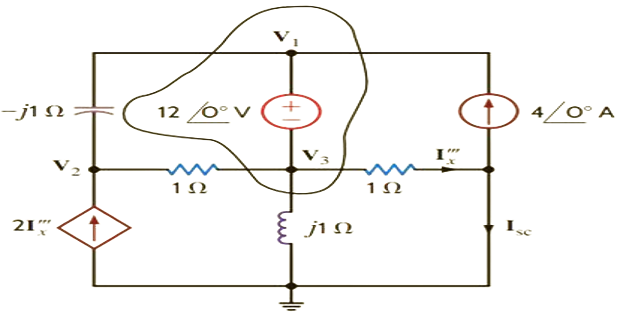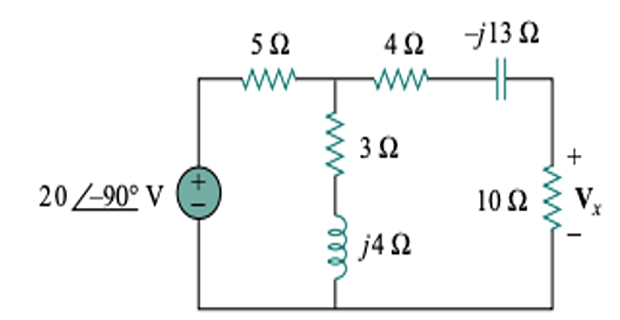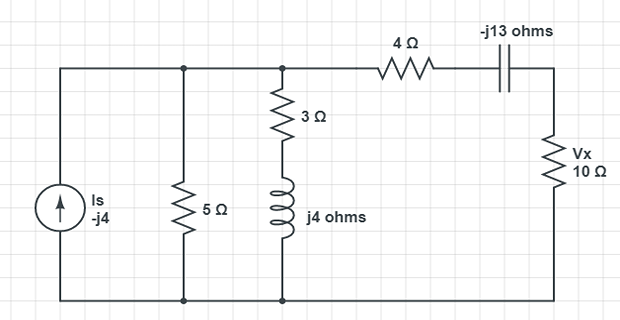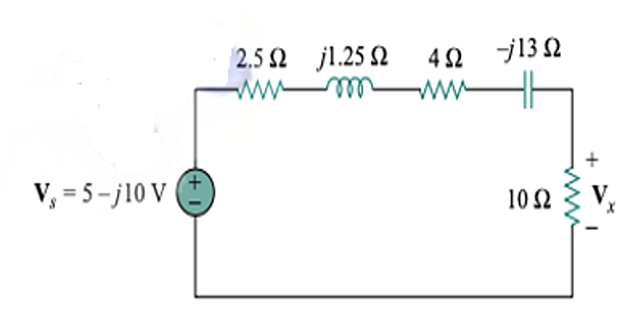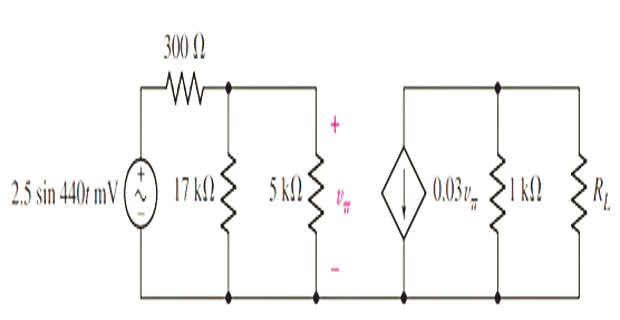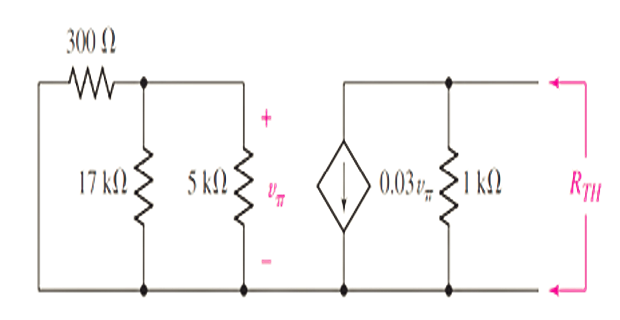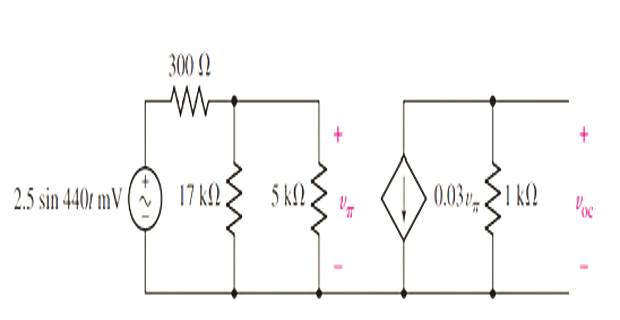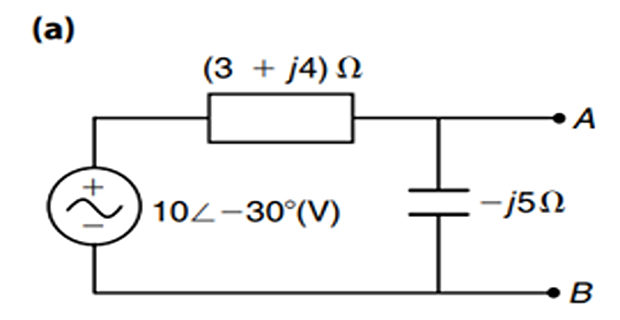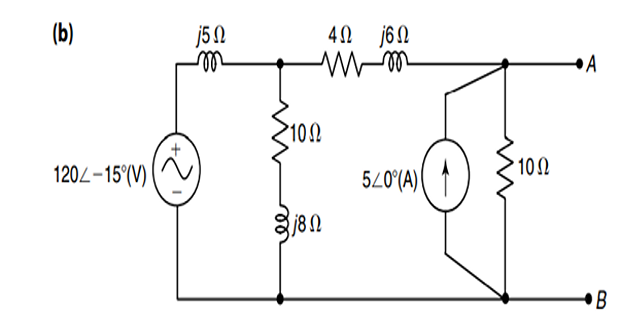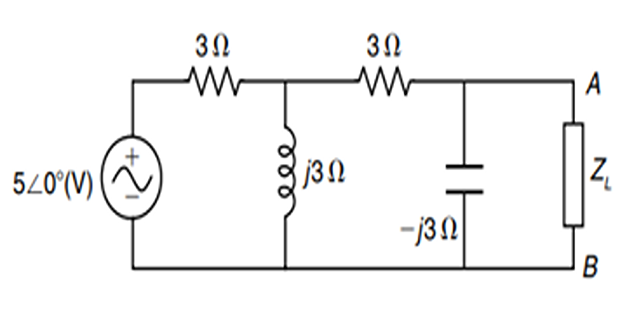Demonstrative Video
VIDEO
Contents
Fundamentals
Problem-1
Solution-1
\[\begin{aligned}
\mathrm{i}_{\mathrm{s}}=& 5 \cos \left(10
\mathrm{t}+40^{\circ}\right)\\
\rightarrow & \mathbf{I}_{\mathrm{s}}=5 \angle
40^{\circ} \\
& 0.1 \mathrm{~F} \longrightarrow \frac{1}{j \omega
\mathrm{C}}\\
&=\frac{1}{j(10)(0.1)}=-j \\
0.2 \mathrm{H} & \longrightarrow \quad j \omega
\mathrm{L}\\
&=j(10)(0.2)=j 2
\end{aligned}\]
\[\begin{aligned}
&\mathbf{Z}_{1}=4 \| \mathrm{j} 2=\frac{\mathrm{j}
8}{4+\mathrm{j} 2}=0.8+\mathrm{j} 1.6 \qquad
\mathbf{Z}_{2}=3-\mathrm{j} \\
&\mathbf{I}_{\mathrm{o}}=\frac{\mathbf{Z}_{1}}{\mathbf{Z}_{1}+\mathbf{Z}_{2}}
\mathbf{I}_{\mathrm{s}}=\frac{0.8+\mathrm{j} 1.6}{3.8+\mathrm{j}
0.6}\left(5 \angle 40^{\circ}\right) \\
&\mathbf{I}_{\mathrm{o}}=\frac{\left(1.789 \angle
63.43^{\circ}\right)\left(5 \angle 40^{\circ}\right)}{3.847 \angle
8.97^{\circ}}=2.325 \angle 94.46^{\circ} \\
&\mathrm{i}_{\mathrm{o}}(\mathrm{t})=\underline{\mathbf{2 . 3 2
5} \cos \left(\mathbf{1 0} \mathbf{t}+\mathbf{9 4 . 4 6}^{\circ}\right)
\mathbf{A}}
\end{aligned}\]
Problem-2
Solution-2
\[\begin{aligned}
& \omega=200 \\
& 50 \mu \mathrm{F} \longrightarrow
\frac{1}{\mathrm{j} \omega \mathrm{C}}=\frac{1}{\mathrm{j}(200)\left(50
\times 10^{-6}\right)}\\
& \quad =-\mathrm{j} 100
\\
& 0.1~\mathrm{H} \longrightarrow j\omega L \\
& \quad = j(200)(0.1) = j20
\end{aligned}\]
\[\begin{gathered}
50 \|-\mathrm{j} 100=\frac{(50)(-\mathrm{j} 100)}{50-\mathrm{j}
100}=\frac{-\mathrm{j} 100}{1-\mathrm{j} 2}=40-\mathrm{j} 20 \\
\mathbf{V}_{\mathrm{o}}=\frac{\mathrm{j} 20}{\mathrm{j}
20+30+40-\mathrm{j} 20}\left(60 \angle 0^{\circ}\right)=\frac{\mathrm{j}
20}{70}\left(60 \angle 0^{\circ}\right)=17.14 \angle 90^{\circ} \\
\mathrm{v}_{\mathrm{o}}(\mathrm{t})=\underline{\mathbf{1 7 . 1 4}
\sin \left(\mathbf{2 0 0} \mathbf{t}+\mathbf{9 0}^{\circ}\right)
\mathbf{V}} \\
\text { or }
\mathrm{v}_{\mathrm{o}}(\mathrm{t})=\underline{\mathbf{1 7 . 1 4} \cos
(\mathbf{2 0 0 t}) \mathbf{V}}
\end{gathered}\]
KCL and KVL
Problem-3
Solution-3
\[\begin{array}{ll}
300 \mathrm{mH} & \longrightarrow j \omega L=j 100
\times 300 \times 10^{-3}=j 30 \\
200 \mathrm{mH} & \longrightarrow j \omega L=j 100
\times 200 \times 10^{-3}=j 20 \\
400 \mathrm{mH} & \longrightarrow j \omega L=j 100
\times 400 \times 10^{-3}=j 40 \\
50 \mu \mathrm{F} & \longrightarrow 1 / j \omega
\mathrm{C}=\frac{1}{j 100 \times 50 \times 10^{-6}}=-j 200
\end{array}\]
\[\begin{aligned}
\text{Mesh-1} \Rightarrow & -120\angle
90^{\circ}+(20+j30)I_1-j30I_2=0 \\
\text{Mesh-2} \Rightarrow & -j30+(j30+j40-j200)I_2+j200I_3=0\\
\text{Mesh-3} \Rightarrow & 80+j200I_2+(10-j180)I_3=0
\end{aligned}\]
\[\left[\begin{array}{ccc}
2+\mathrm{j} 3 & -\mathrm{j} 3 & 0 \\
-3 & -13 & 20 \\
0 & \mathrm{j} 20 & 1-\mathrm{j} 18
\end{array}\right]\left[\begin{array}{c}
\mathrm{I}_{1} \\
\mathrm{I}_{2} \\
\mathrm{I}_{3}
\end{array}\right]=\left[\begin{array}{c}
\mathrm{j} 12 \\
0 \\
-8
\end{array}\right]\]
Problem-4
Solution-4
\[\begin{aligned}
\omega & = 10^3~\text{rad/s} \\
X_L & = j\omega L = j10~\Omega \\
X_C & = \dfrac{-j}{\omega C} = -j10~\Omega\\
V_1 & = 20\angle 0^{\circ} \quad V_2 = 20\angle
-90^{\circ}
\end{aligned}\]
\[\begin{aligned}
&\Rightarrow V_{x}\left[\frac{1}{j 10}-\frac{1}{j
10}+\frac{1}{25}\right]=\frac{20}{j 10} \angle 0^{\circ}-\frac{20}{j 10}
\angle-90^{\circ} \\
&\Rightarrow \frac{V_{x}}{25}=(2-j 2) \Rightarrow V_{x}=50-j
50=70.71 \angle-45^{\circ}(\mathrm{V}) \\
&\therefore v_{x}(t)=70.71 \cos \left(1000
t-45^{\circ}\right)(\mathrm{V})
\end{aligned}\]
KCL at node
Problem-5
Solution-5
\[\begin{aligned}
V_c & = \dfrac{1}{j\omega C} I_c = 1\angle
-62^{\circ}~\mathrm{V}\\
I_{R2} & = \dfrac{V_c}{2} = 0.5
\angle -62^{\circ}~\mathrm{A}\\
I_s & = I_{R2}+I_c = 1.5\angle -62^{\circ}~\mathrm{A}\\
\end{aligned}\]
\[\begin{aligned}
i_s(t) &= 1.5 \cos (2t-62^{\circ})~\mathrm{A}
\end{aligned}\]
Problem-6
Solution-6
\[\begin{aligned}
\omega & =2~\text{rad/sec},~L_1 = 0.5~\text{H}~L_2 =
1~\text{H}~C = 0.5~\text{F}\\
X_{L1} & = j1~\Omega, ~X_{L2} = j2~\Omega, ~X_{c} =
-j1~\Omega, ~
\end{aligned}\]
On solving:
Thevenin’s Theorem
Problem-7
Solution-7
\[\begin{aligned}
I & = \dfrac{10\angle 0^{\circ}}{100+j10} \\
&= 0.09995\angle -5.7^{\circ}~\mathrm{A}\\
V_{Th}&=V_{AB} \\
&= \left(I\times j 10\right)-\left(5I\times
(-j5)\right)\\
& = 3.48\angle 84.3^{\circ} ~\mathrm{V}
\end{aligned}\]
Problem-8
Solution-8
\[\begin{aligned}
2~\Omega & \Rightarrow \text{open} \\
i_0 & = I_1 \\
\text{KVL-1} & ~(4-j4)I_1+j4I_2 = -12 \\
\text{KVL-2} & ~-j2I_1+(-j6)I_2 = 0\\
\text{Solving} ~ I_2 & = 0.6\angle 53.13^{\circ}
~\mathrm{A} \\
V_{Th} & = I_2 \times (-j8) \\
& = 4.8\angle -36.87^{\circ} ~\mathrm{V}
\end{aligned}\]
\[\begin{aligned}
2~\Omega & \Rightarrow \text{short and dep. source
transformation} \\
\text{KVL} ~& (4-j4)I_1+j4I_2 = -12\\
\text{Solving} ~I_2 & = I_N = 1.34\angle 63.43^{\circ} \\
Z_{TH} & = \dfrac{V_{TH}}{I_N} = 3.58\angle
-100.3^{\circ}~\Omega \\
v_0 & = \left(\dfrac{V_{TH}}{Z_{TH}+2}\right) \times 2
= 1.27 \angle 32^{\circ}
\end{aligned}\]
Problem-9
Solution-9
\[\begin{aligned}
\mathbf{V}_{3}+12 \angle 0^{\circ} &=\mathbf{V}_{1} \\
\frac{\mathbf{V}_{2}-\mathbf{V}_{1}}{-j
1}+\frac{\mathbf{V}_{2}-\mathbf{V}_{3}}{1}-2 \mathbf{I}_{x}^{\prime
\prime \prime} &=0 \\
\frac{\mathbf{V}_{1}-\mathbf{V}_{2}}{-j
1}+\frac{\mathbf{V}_{3}-\mathbf{V}_{2}}{1}-4 \angle
0^{\circ}+\frac{\mathbf{V}_{3}}{j 1}+\mathbf{I}_{x}^{\prime \prime
\prime} &=0 \\
\mathbf{I}_{x}^{\prime \prime \prime} &=\frac{\mathbf{V}_{3}}{1}
\end{aligned}\]
\[\left[\begin{array}{cccc}
-1 & 0 & 1 & 0 \\
-\mathrm{j} & (1+\mathrm{j}) & -1 & -2 \\
\mathrm{j} & -(1+\mathrm{j}) & 1-\mathrm{j} & 1
\\
0 & 0 & -1 & 1
\end{array}\right]\left[\begin{array}{c}
\mathbf{V}_{1} \\
\mathbf{V}_{2} \\
\mathbf{V}_{3} \\
\mathbf{I}_{x}^{\prime \prime \prime}
\end{array}\right]=\left[\begin{array}{r}
-12 \\
0 \\
4 \\
0
\end{array}\right]\]
\[\begin{aligned}
\mathbf{I_x^{'''}}& = 2.8284\angle
135^{\circ}~\mathrm{A} \\
\mathbf{I_x^{'''}}& = 4\angle 0^{\circ} +
\mathbf{I_{sc}}\\
\mathbf{I_{sc}}& = 6.3245\angle
161.57^{\circ}~\mathrm{A}
\end{aligned}\]
The matrix equation is
\[\begin{aligned}
Z_{TH} & = (1-j)~\Omega \\
V_0 & = I_{sc}
\left[(1)(1-j)/(1+1-j)\right]~\mathrm{V}\\
& = 4 \angle 143.13^{\circ} ~\mathrm{V}
\end{aligned}\]
Problem-10
Solution-10
\[\mathbf{I}_{s}=\frac{20 \angle -90^{\circ}}{5}=4
\angle-90^{\circ}=-j 4 \mathrm{~A}\]
\[\mathbf{Z}_{1}=\frac{5(3+j 4)}{8+j 4}=2.5+j 1.25
\Omega\]
\((3+j 4)\) \(5-\Omega\) Transform the voltage source to a current source
\[\mathbf{V}_{s}=\mathbf{I}_{s} \mathbf{Z}_{1}=-j
4(2.5+j 1.25)=5-j 10 \mathrm{~V}\]
\[\mathbf{V}_{x}=\frac{10}{10+2.5+j 1.25+4-j
13}(5-j 10)=5.519 \angle-28^{\circ} \mathrm{V}\]
Converting the current source to a voltage source
Maximum Power Transfer
Theorem
Problem-11
Solution-11
Since \(v_{\pi}=0\) , the
dependent current source is an open circuit, and \(R_{T H}=1 \mathrm{k} \Omega\) . This can be
verified by connecting an independent \(1
\mathrm{~A}\) current source across the \(1 \mathrm{k} \Omega\) resistor; \(v_{\pi}\) will still be zero, so the
dependent source remains inactive and hence contributes nothing to \(R_{T H}\) .
\[v_{\mathrm{oc}}=-0.03 v_{\pi}(1000)=-30
v_{\pi}\]
\[p_{\max }=\frac{v_{T H}^{2}}{4 R_{T H}}=1.211
\sin ^{2} 440 t \mu \mathrm{W}\]
\(1
\mathrm{k} \Omega\) \(-69.6 \sin
440 t \mathrm{mV}\) \[v_{\pi}=\left(2.5 \times 10^{-3}
\sin 440 t\right)\left(\frac{3864}{300+3864}\right)\]
\(v_{\pi}\) . should be set to In order to obtain maximum power delivered into the load,
Problem-12
Solution-12
\[Z_{\text {th }}=\frac{(3+j 4)(-j 5)}{3+j 4-j
5}=7.9 \angle-18.43^{\circ} \Omega=(7.5-j 2.5) \Omega\]
\(Z_{L}=Z_{\text {th
}} *=(7.5+j 2.4) \Omega\) is and Equivalent impedance with respect to the terminals
\[\begin{aligned}
Z_{\mathrm{th}} &=\left[\frac{(10+j 8) j 5}{10+j 8+j
5}+4+j 6\right]|| 10\\
&=\left(\frac{-40+j 50+40+j 52+j 60-78}{10+j
13}\right)|| 10 \\
&=6.14 \angle 30^{\circ} \Omega=(5.316+j 3.07) \Omega
\end{aligned}\]
\(Z_{L}=Z_{\text {th }} *=6.14 \angle-30^{\circ}
\Omega=(5.316-j 3.07) \Omega\) is and Equivalent impedance with respect to the terminals
Problem-13
Solution-13
\[V_{\mathrm{th}}=\frac{5 \angle
0^{\circ}}{3+\frac{j 3(3-j 3)}{3-j 3+j 3}} \times\left(\frac{j 3}{3+j
3-j 3}\right)=\frac{45 \angle 0^{\circ}}{18+j 9}=2.236
\angle-26.56^{\circ}(\mathrm{V})\]
, the Thevenin voltage is
and With respect to terminals Thevenin impedance, \(Z_{\mathrm{h}}=\frac{\left(3+\frac{3 \times j
3}{3+j 3}\right) \times(-j 3)}{3+\frac{3 \times j 3}{3+j 3}-j 3}=3
\angle-53.12^{\circ} \Omega=(1.8-j 2.4) \Omega\)
For maximum power transfer, \(Z_{L}=Z_{\text {th }}{ }^{*}=(1.8+j 2.4)
\Omega\)
Current, \(I=\frac{2.236
\angle-26.56^{\circ}}{1.8 \times 2}=0.621 \angle-26.56^{\circ}
\mathrm{A}\)
The value of the maximum power is, \(P_{\max }=\frac{\left(V_{\text {th
}}\right)^{2}}{4 R}=\frac{(2.236)^{2}}{4 \times 1.8}=0.694
\mathrm{~W}\)
